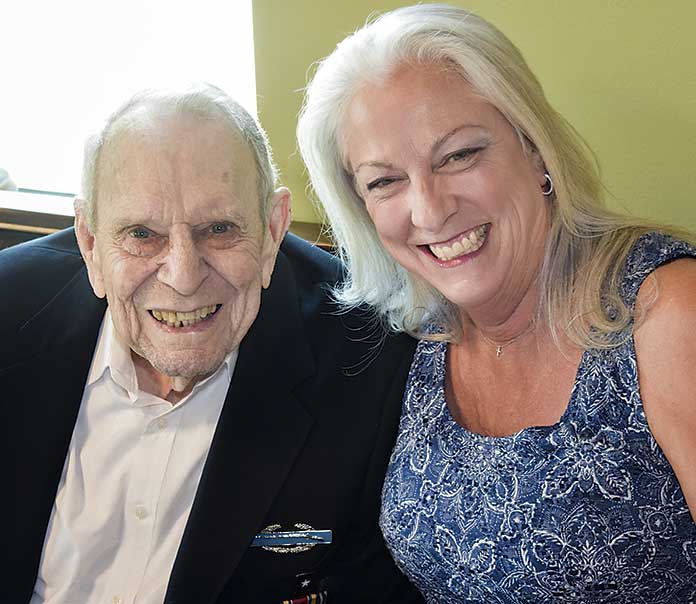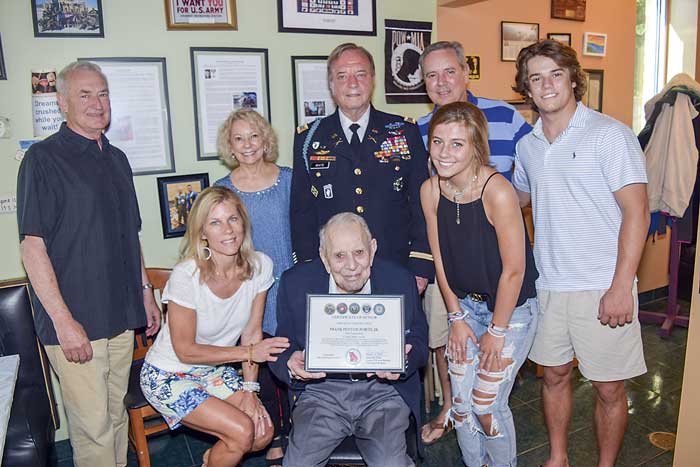The bright, sunny skies on May 18 were no match for the bright smile on the face of 96-year-old Frank Forth as he walked through the door of Mimi’s Good Food restaurant in Peachtree City, where a group of family and friends were waiting to welcome the World War II veteran and to offer their support to see that Forth is inducted into the Georgia Military Veterans Hall of Fame.
Advocating for Forth in a nomination letter to the Georgia Military Veterans Hall of Fame were Mimi’s Restaurant owner Mimi Gentilini and Peachtree City resident Terry Garlock.
The nomination letter outlined Forth’s efforts in the fight for freedom at the Battle of the Bulge in December 1944 and January 1945. The letter also chronicled Forth’s life and his contributions during the decades that followed the World War II.
As a matter of perspective, the Battle of the Bulge was the largest and bloodiest single battle fought by the U.S. in World War II, according to historians David McCullough and Stephen Ambrose. U.S. casualties totaled 89,000, of which more than 19,000 were killed, according to military historian Donna Miles.
“By sheer determination and sacrifice, the World War II generation rescued the world from spreading evil. Frank Forth is a fine example,” the letter began.
At the end of his sophomore year studying Forestry at the University of Florida, ROTC student Frank Forth was called up to active duty in the US Army during World War II, Garlock and Gentilini explained.
“Frank hoped for pilot training so he could fly. Naturally, the Army trained him in the art of Infantry. When he arrived at the front in Belgium, Frank was assigned to the 84th Division, 333rd Infantry, joining the fight at the Battle of the Bulge,” the letter continued.
“This was a huge battle, Hitler’s desperate last offensive on the Western Front trying to push back the Allies in the coldest winter on record. Digging a foxhole was furious work in the frozen ground. Enemy artillery and 88mm tank guns were firing all around Frank and his fellow soldiers. Deadly shrapnel that cut some soldiers to pieces rained down on them as shells detonated in treetops, but they feared even more the white phosphorous shells since that pretty white substance spread and would burn right through a man. The Germans booby-trapped everything, including our dead soldiers.
“Fighting German ‘snow troops’ camouflaged in white, Frank’s unit fixed bayonets to rifles to clear Germans out of a forest segment in grisly hand-to-hand fighting. A German sniper nearly got Frank when a round punched a hole in his coat, and he survived an intense artillery barrage without a scratch. Later, while climbing a hill to take out a German observation post, Frank slipped down in the snow just as a mortar shell exploded that would have killed him had he remained on his feet. A French Catholic Nun had given Frank and his men “Miraculous metals” to carry on their dog tag chains, blessed by a Priest, and whether Catholic or Protestant they all wore them. Frank is quite certain God was watching over him.
“In that battle, the winter cold killed as many Americans as combat. Severe cold kept some weapons from firing and grounded our airplanes so there was no air support. A soldier’s sweat from extreme exertion soaked their overcoat then froze, making the coats so heavy that soldiers discarded them. Many American soldiers, bone-weary, just sat down, leaned against a tree, went to sleep and froze to death.
“Surrounded by dead men, Frank became exhausted. He knew what the symptoms were and realized he was freezing to death. Frank pulled himself inch by inch out of his foxhole to sit down with his weary back to a tree. When all seemed lost, one of the crew from an American Sherman tank brought him a hot cup of coffee that he could hardly believe was real.
“Frank was taken to a field hospital and was treated there and long after at home. Ultimately, he was discharged due to severe frostbite to his feet. He later served on active duty during the Korean War,” the letter noted.
The nomination letter penned by Garlock and Gentilini continued, citing aspects of Forth’s succeeding years. Those comments included aspects of his work and interests. Forth is a man who continued to contribute to the country for which he risked his life during Germany’s last major offensive on the Western Front.
“He finished his degree in Forestry from the University of Florida, and worked as a Forestry Supervisor for the St. Regis Company. He sold books to school systems for Random House. He became licensed as an appraiser, real estate agent and broker and ran his own company, Forth Realty and Appraisals. Frank wrote a book about Native American artifacts and has quite a collection. His other hobby is woodworking, turning quality wood into beautiful furniture for special people. He was a Lions Club member over 30 years, and along the way had a full family life.
“Frank even realized his early dream of flying. He owned an airplane and flew search and rescue missions for the Civil Air Patrol. When he was 84 Frank wrote a novel titled “The Forester’s Notebook.”
“Now nearly 96 years old, Frank Forth gives new meaning to ‘gracious, greeting with a warm smile every person he meets. America should be proud to have such ‘citizen soldiers.’”
A Fayetteville resident since 2016, Forth lived in Peachtree City from 2007-2016 and has been a Georgia resident for 65 years. — Story by BEN NELMS
Honoring a WWII veteran, and others like him
By Terry Garlock
Once in a rare while an opportunity arises to do something good on behalf of all of us, including you. On Saturday, May 18, one of those good things happened at Mimi’s in Peachtree City, my daily coffee hangout, where the staff are not just service providers but buddies, too, where friends gather for a meal, to trade laughs, tell tales and get away with their embellishments so long as an eye witness is not listening.
Mimi Gentilini has a favorite customer, Frank Forth, soon to be 96 years old. She takes Frank every year as her date to a WWII Days dance celebration. Mimi and I conspired to make last Saturday special for Frank and his family.
For our special occasion Mimi prepared very nice tables of pastries and snacks, and she invited a bunch of people who know and love Frank.
My part was doing research on Frank’s role in the Battle of the Bulge near the end of WWII, with the help of Frank’s daughter, Leslie, and making some special arrangements to honor his service.
In honoring Frank, by proxy we were also paying tribute to all in that generation, including my father and perhaps some in your own family tree, who by their determination and sacrifice did no less than save the world from the evil spreading around the globe.
When I turned on the microphone to start our program, I briefly introduced US Army Colonel (retired) Rick White, also Chairman of the Board of the Georgia Military Veterans Hall of Fame. I had prepared and submitted a package on Frank Forth, a joint submission by me and Mimi, nominating Frank to be inducted into the Hall of Fame. We won’t know the selection committee’s decision until this fall, but on Saturday Col. White came to make a special presentation, as is his custom for WWII veterans given their advanced age.
He took the microphone and explained why he was wearing his Army dress blues uniform. He said it was a gesture of respect for the veteran he was honoring, and from that point of view he said “ . . . these are the best clothes I own.”
Col. White read part of the nomination package I submitted which summarizes Frank’s role in WWII, as follows:
When he arrived at the front in Belgium, Frank was assigned to the 84th Division, 333rd Infantry, joining the fight at the Battle of the Bulge.This was a huge battle, Hitler’s desperate last offensive on the Western Front, sending 250,000 more German troops to push back the Allies in the coldest winter on record.
Digging a foxhole was furious work in the frozen ground. Enemy artillery and 88mm tank guns were firing all around Frank and his fellow soldiers. Deadly shrapnel that cut some soldiers to pieces rained down on them as shells detonated in treetops, but they feared even more the white phosphorous shells since that pretty white substance spread and would burn right through a man. The Germans booby-trapped everything, including our dead soldiers.
Fighting German “snow troops” camouflaged in white, Frank’s unit fixed bayonets to rifles to clear Germans out of a forest segment in hand-to-hand fighting too grisly for words. A German sniper nearly got Frank when a round punched a hole in his coat, and he survived an intense artillery barrage without a scratch.
Later, while climbing a hill to take out a German observation post, Frank slipped down in the snow just as a mortar shell exploded that would have killed him had he remained on his feet.
A French Catholic Nun had given Frank and his men “miraculous metals” to carry on their dog tag chains, blessed by a Priest, and whether Catholic or Protestant they all wore them. Frank is quite certain God was watching over him.
In that battle the winter cold killed as many Americans as combat. Severe cold kept some weapons from firing and grounded our airplanes so there was no air support. A soldier’s sweat from extreme exertion soaked their overcoat then froze, and froze more sweat later, making the coats so heavy that soldiers discarded them. Many American soldiers, bone-weary, just sat down, leaned against a tree, went to sleep and froze to death.
Surrounded by dead men, Frank became exhausted. He knew what the symptoms were and realized he was freezing to death. Frank pulled himself inch by inch out of his foxhole to sit down with his weary back to a tree. When all seemed lost, one of the crew from an American Sherman tank brought him a hot cup of coffee that he could hardly believe was real.
Frank was taken to a field hospital and was treated there and long after at home. Ultimately he was discharged due to severe frostbite to his feet. He later served on active duty during the Korean War.
He finished his degree in Forestry from the University of Florida, and worked as a Forestry Supervisor for the St. Regis Company. He sold books to school systems for Random House. He became licensed as an appraiser, real estate agent and broker and ran his own company, Forth Realty and Appraisals. Frank wrote a book about Native American artifacts and has quite a collection. His other hobby is woodworking, turning quality wood into beautiful furniture for special people. He was a Lions Club member over 30 years, and along the way had a full family life.
Frank even realized his early dream of flying. He owned an airplane and flew search and rescue missions for the Civil Air Patrol. When he was 84 Frank wrote a novel titled The Forester’s Notebook.
Soon to be 96 years old, Frank Forth gives new meaning to “gracious,” greeting with a warm smile every person he meets. America should be proud to have such ‘citizen soldiers.’”
After reading this summary of Frank’s contribution to our country, Col. White presented to Frank a very nicely prepared Certificate of Honor framed for hanging on a wall.
My buddy Tony Armstrong was there snapping lots of photos.
Frank received a lot of love from his family and from friends in attendance; many of them wrote their personal comments in a signature book, intended to be part of a memory album including all the photos.
Making this a special evening for Frank and his family was a privilege for Mimi and I, and for all of the friends who came to pay their respects. I hope every WWII veteran who reads this will take from it the intended recognition and gratitude from all of us, your fellow citizens, who know and appreciate what you did for your country in a time long ago when the outcome was anything but certain.
———————
Terry Garlock of Peachtree City occasionally contributes a column to The Citizen. [email protected]













Leave a Comment
You must be logged in to post a comment.